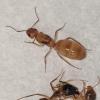Colorado Antweb for convenience
Edited by Waganga, May 10 2018 - 7:22 PM.

Colorado Antweb for convenience
Edited by Waganga, May 10 2018 - 7:22 PM.
I'm not sure if these are even Camponotus, they appear to be Formica to me.
Agreed.
The lunch meat pic especially looks like either F. Subsericea or F. Argentea. Time for a turkey sandwich.
I think you guys are certainly right. I suppose I assumed they were Camponotus because of their size, and also their choice of nesting site? I didn't realize there were so many species of larger ant. They don't look much like the Formica pictured on Antweb, because those all look too brown to me, but they certainly do look exactly like the F. Argentea pictured here:
https://www.alexande...gus/i-STKpnhr/A
But, they also look a lot like the F. Fusca pictured here:
https://www.alexande...ica/i-vVs8spn/A
I think F. Argentea is more likely, but how would I go about determining which is correct?
I suspect either Formica podzolica, Formica subsericea, or Formica argentea.
Formica fusca is smaller and is a solid shiny black all over, rather than having stripes of different shades of black on the gaster.
Edited by Mettcollsuss, May 11 2018 - 3:08 AM.
 |
Ants & Myrmecology →
General →
Anting (ants catching) in ColoradoStarted by Bigpimpbiscuit , Yesterday, 3:30 PM |
|

|
|
 |
Market Place →
General Market Place →
Georgia - All must go!Started by sanlefa , Apr 9 2025 |
|

|
|
 |
Market Place →
General Market Place →
[CA] Looking for Formica (can buy/trade)Started by bmb1bee , Apr 8 2025 |
|
![[CA] Looking for Formica (can buy/trade) - last post by bmb1bee](https://www.formiculture.com/uploads/profile/photo-thumb-6841.jpg?_r=1649821237)
|
|
 |
Anting →
Ant ID Requests →
Help me identify an ant species found near me, somerset black antStarted by CarvedPumpkinPie , Apr 4 2025 |
|

|
|
 |
Anting →
Ant ID Requests →
Orange Pheidole, Mesa AZStarted by Ants4ever7 , Mar 28 2025 |
|

|
0 members, 0 guests, 0 anonymous users